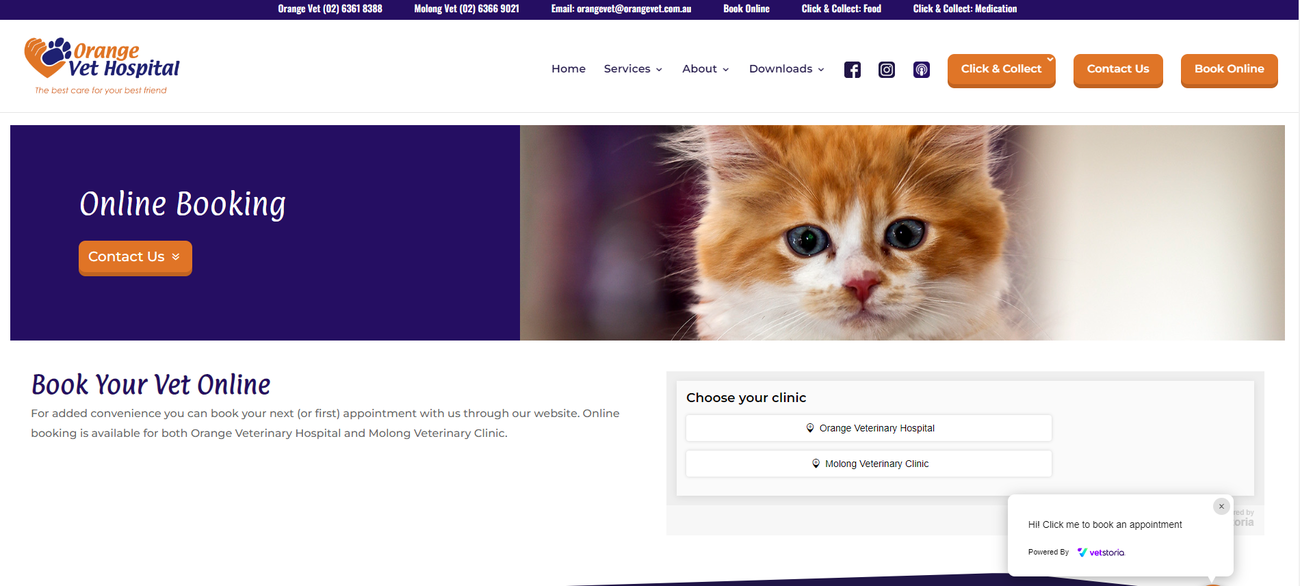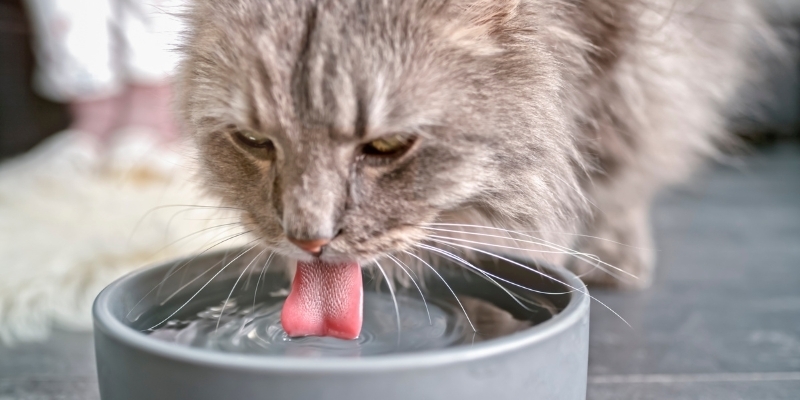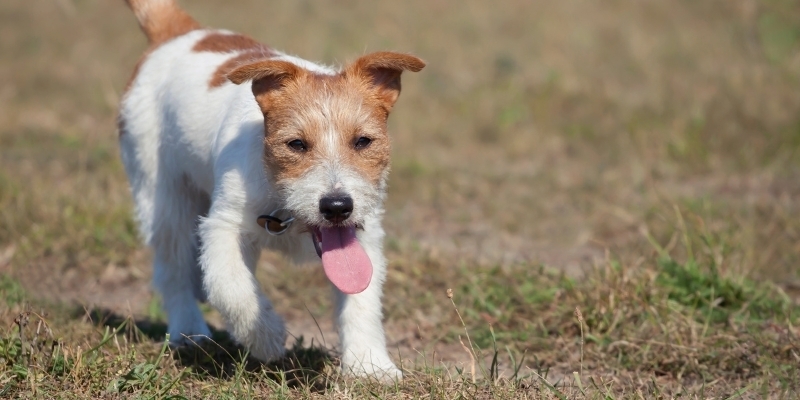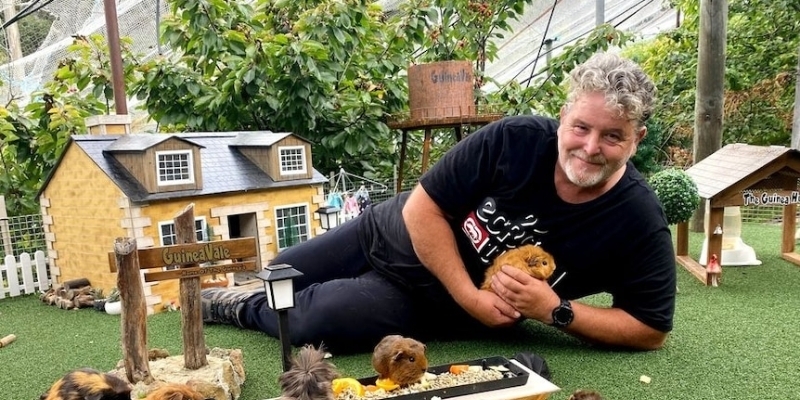| February 2023- Pet Care Newsletter |
|
|
| | | This month, our newsletter is a little heavier than it often is- we cover some big issues, including pet insurance, cancer care and chronic kidney disease.
Exciting news- nurses Jacq and Elle have both finished at university, finishing their Veterinary Technology degrees. This has been a lot of hard work for the girls, and we are so proud of them!
Regulars to the clinic will be pleased to know that Ryan is back on deck! Sadly, Jacq has taken an opportunity to move to the city to explore an exciting professional opportunity. Grace is also heading off to university to study Veterinary Science at Charles Sturt University. We may be lost without these girls, but we are excited for the opportunities that they both have ahead! | | | Book Online |
|
|
 | | Pet insurance- reducing the pain on the hip pocket | | | Pet insurance may offer peace of mind that you are in a better position to afford care. We cannot recommend any specific policy as they are all different and suit each individual needs, and we are not financial advisors. Your vet may have some input as to which companies seem easier to deal with than others.
In recent years there has been significant advances in veterinary treatment and advanced options available for diagnostics and treatment. Some of these options we can work through here, and some need specialist care in Sydney or Canberra. These can be costly compared to human health care, industry which is heavily subsidised by government programs including Medicare and the Pharmaceutical Benefits scheme. This is not the case in the veterinary industry- the government provides no such input.
It is best to insure an animal when they are young and healthy, as this often means they don’t have a pre-existing condition that cannot be claimed for during their policy. This makes pet insurance different to human insurance, where even pre-existing conditions tend to be waived over the long term if your level of cover is right. Insurance is generally more expensive as your pets get older.
• What type of insurance is available
o Accident and illness- In accident or suffers from a disease or illness
o Accident only- Limited/basic that covers a portion if our animal is injured such as HBC
o Comprehensive- Top tier – cover all of the above and also other circumstances such as ongoing care
What may not be covered
o PRE-EXISTING CONDITIONS
o Routine check ups
o Dental (although some policies now include this- read the fine print)
o Vaccinations (although some policies now include this- read the fine print)
o Behaviour (although some policies now include this- read the fine print)
o Desexing (although some policies now include this- read the fine print)
o Parasite control
o Pregnancy and pregnancy related complications
o Grooming
o Generally does not cover for diseases that are preventable with vaccinations – important to keep up vaccinations
How to choose cover- we encourage you to read the fine print and understand what you are or are not signing up for.
o Maximum annual benefit – how much the insurer will pay out each year
o What’s incl excluded
o Annual benefits – are there extras and limits for conditions such as tick paralysis
o Excess - sum you need to pay on each claim
o Dental – common exclusion on policies
Some bigger veterinary centres in major centres can offer gap fee, but at our clinic we require full payment and then the client makes a claim through the insurer to recuperate some of the cost. This is an important factor to consider, and some people like to put the fee onto their credit card and hope that the pet insurance company can reimburse before the credit card is due.
| | | Pet Insurance- Information from Australian Veterinary Association |
|
|
 | | Online bookings | | | Every day we take an average of 700 calls, many of which involve booking appointments.
To ease telephone congestion, and prevent our clients being put on hold, we have created an online booking system!
With a simple click of a button you get the ease of booking, cancelling and rescheduling appointments.
You can find this feature on our website: https://orangevet.com.au/bookings/
The other bonus feature is that you can order food and medication using our online booking system too!
We just ask that you give us 12-24 hours to process these as we get many requests throughout the day
| | | Book Online |
|
|
 | | Optimistic oncology | | | It’s natural to feel a little worried if you find an unusual lumps or bumps on your pet.
Our team are here to reassure you that with prompt treatment, there’s a good chance of a positive outcome for your pet. Here are two potential ways we could achieve a good result:
1. Not every lump is nasty
As well as malignant (cancerous) tumours, there are many other causes of lumps in pets that are less of a cause for concern. These include:
- Benign tumours – these are tumours that are unlikely to spread and cause harm in your pet’s body, including lipomas (“fatty lumps”), histiocytomas and benign sebaceous tumours (“old dog warts”)
- Skin tags – these are small skin growths that are thought to be associated with persistent irritation or pressure
- Cysts – these hollow swellings may contain fluid or thick, cheesy material
- Papillomas – these are wart-like lumps caused by dog papillomavirus
Whilst these masses are all considered benign, they may be associated with irritation or discomfort in some pets and therefore may still require surgical removal. Usually, our first step is taking a fine needle aspirate of a lump if it is bigger than a pea- and checking it under the microscope.
Swelling on or beneath the skin of pets may also be caused by inflammation or infection. Common causes for these types of swelling include:
- Hives – these are allergic skin swellings that can occur after insect stings or contact with an irritating plant
- Abscesses – these are pockets of infection that often occur secondary to tooth root infections or a cat bite, or due to a penetrating foreign body such as a grass seed
2. Prompt treatment can be curative
If testing of your pet’s mass does confirm a cancerous lump, there is still a good chance of cure with prompt treatment. In many cases, this includes surgical removal of the mass, and if needed, we are able to give chemotherapy here in Orange with the help of our colleagues. The photo above is of one of our patients on chemotherapy at the moment- she seems pretty happy about completing week 4 of her chemotherapy with Georgia and Mei Mei this week! Her oncology specialist has helpful information available for pet owners at the link below.
So, if you find a new lump on your pet, keep calm and book a consultation. We’ll help bump off that lump in no time!
|
|
|
| The urge to itch | | | Over the past fortnight we have seen many, many itchy dogs! With the recent drying weather, the grasses and weeds are much more irritating and seasonal itches are flaring up.
If your dog is itchy at home, the best first option is often a soothing bath with an Oatmeal shampoo. If that is not enough, check that your pet's regular or previously prescribed itching medications are on track.
Short of that, get one of our vets to help you out with an appointment. You might want to download this itch tracker below to give your vet an idea on how the itch is tracking! | | | Itch tracker |
|
|
 | | Kitty kidney kindness | | | Chronic kidney disease (or CKD) is particularly common in elderly cats, and involves a progressive deterioration in kidney function. Whilst early CKD rarely causes any obvious signs in affected cats, cats with more advanced disease can show symptoms of unwellness, including weight loss, reduced appetite, poor coat quality, and increased drinking and urination. CKD can also predispose them to secondary health problems, such as urinary tract infections or high blood pressure.
Whilst a diagnosis of CKD in your cat can certainly be worrying, rest assured that with early detection and management, affected cats can still have a good quality of life and may live with the disease for several years. Here’s how to proactively maximise your cat’s kidney health potential:
1. From eight years of age, book veterinary health checks for your cat every six-to-12 months
During these health checks, our vets can assess your cat’s overall body condition and musculature. Any weight loss should ideally be investigated with blood and urine tests to screen for early kidney deterioration.
2. If your cat is diagnosed with kidney disease, implementing these simple management strategies can help slow the deterioration of your pet’s kidneys and help them to feel well for longer:
- Perform a switch to a prescription kidney support diet with reduced levels of protein, salt and phosphorous, which can reduce the strain on your cat’s kidneys. For cats that do not yet have kidney disease, geriatric specific diets like Royal Canin Senior Consult can be very helpful
- Ensure your cat always stays well-hydrated by feeding them a portion of their diet as wet food and encouraging them to drink water – this may involve the use of particular bowls that your cat prefers, adding tuna juice to their water, or using special pet drinking fountains
- Have your pet‘s condition checked every six months, including urine testing (to screen for any secondary urinary tract infections) and measurement of their blood pressure
With some good care, your elderly little feline friend can hopefully enjoy several more years of good-quality snuggles with you. |
|
|
 | | Keeping those hearts happy | | | Mitral valve disease (MVD) is a degenerative heart condition most commonly seen in middle-aged to older small-breed dogs. It involves the progressive thickening and dysfunction of valves within the heart, eventually leading to heart disease symptoms in some dogs.
Whilst this sounds pretty scary, the good news is that our vets can offer lots in the way of screening, monitoring and support of pets affected by MVD to help extend their lifespan and maintain their quality of life.
1. Screening pets for MVD
Many cases of MVD in pets are first discovered during routine health checks by the detection of a heart murmur (an unusual heart sound). For this reason, we recommend health checks every six-to-12 months in all dogs eight years old and above, particularly for at-risk breeds such as Cavalier King Charles spaniels. Cavaliers are at such risk that some medications are recommended even before signs of heart disease are noted, though this can become costly over time.
2. Monitoring pets for heart disease
If a murmur suggestive of MVD has been detected, we will discuss various monitoring options based on that pet’s particular condition. These include:
- Monitoring the pet’s sleeping breathing rate – an increase above 30 breaths per minute when they’re deeply asleep (and not dreaming!) warrants a prompt veterinary recheck
- Chest x-rays to measure the size of the pet’s heart and look for any signs of fluid accumulation in or around their lungs
- Monitoring the pet for any symptoms of heart disease, such as becoming puffed with exercise. Download the Boehringer Heart2Heart app and share the results with your veterinarian
- Electrocardiography if your pet has an abnormal heart rhythm
- For some pets, heart ultrasound (echocardiography)
3. Treating pets for symptoms of heart disease
If pets with MVD proceed to a more advanced stage of heart disease, our vets will discuss medical options to reduce their symptoms and improve their quality of life.
Whilst we sadly can’t cure pets of heart disease, we can help protect your heart and theirs by maximising the quality and quantity of time you spend together. |
|
|
 | | Animal News In Brief | | |
Guinea pig town goes TikTok viral
Vienna will have some serious competition for the most livable city this year! A little-known and relatively new town has popped up in an unassuming backyard in Collinsvale, Tasmania. ‘GuineaVale’ is home to 37 guinea pigs. When they bought their first guinea pigs, the Ransley family simply needed a few tiny farm hands to help mow (or eat) the lawn under the orchards. “They turned out to be good lawnmowers but I fell in love with the guinea pigs, myself,” said Steve Ransley, grandfather, creator, and town planner of ‘GuineaVale’. Mr Ransley’s tiny village is complete with handmade cottages, lampposts, lounges, campground tables laden with fruit and veg, and even a miniature water tower. Videos of life in this ‘piggy paradise’ have become a social media sensation. “The grandkids said ‘You’ve gotta put ‘em on TikTok, Pop!’. They got a couple of thousand views, then 10,000, then 100,000, now they’re getting millions,” said Mr Ransley. Plans are in the works to expand GuineaVale to include a custom church and pint-sized pub. With a twinkle in his eye, Mr Ransley assures his fans that “the pub will serve, obviously, ‘Guinness’”.
Visit ABC News to see video of GuineaVale and its furry residents and view the full interview with Steve Ransley.
Pictured: Steve Ransley reclines with pet guinea pigs at 'GuineaVale'. Image source: ABC News
The pomeranian and the python
When Amanda Taylor and her three dogs headed off for a walk around Noosa Woods shortly after Christmas, she wasn’t expecting to return home as a local hero. But when a three-and-a-half metre long python set eyes (and tail) on her two-year-old pomeranian, Ferrari, Amanda was forced into action. “All of a sudden, little ‘Rari was screaming. I wasn’t sure what was happening because it was happening so quickly. The snake was coiling around his head. I just shook it and shook it until it started to uncoil. [Then] I had it in my arms, and I hurled it into the water,” said Amanda. While non-venomous, the three-and-a-half-metre coastal carpet python’s brief but powerful squeeze was strong enough to leave little Ferrari with a burst blood vessel in his eye, but no other injuries. “I was very proud of mum. Mum’s such a weapon for grabbing the snake!” said proud daughter, Jessica Taylor.
Watch the full interview with Amanda and Jessica Taylor on ABC News.
Floss of the Kimberleys
You might have heard the great Aussie yarn of the red dog of the Pilbara, but have you heard of the red dog of the Kimberley? When a truck driver opened his cab to a stray dog in Western Australia, neither of them could have known that they were in for a grand buddy adventure. What was supposed to be a straight run from Kununurra to the Perth Dog’s Refuge Home, would turn into an epic 20,000km journey around Australia. Floss and her driver Barry Horsman made it to Geraldton, WA, before unforeseen circumstances and delivery duties required Barry to make a few additional stops along the way. Together, they made deliveries to Echuca, Victoria, then up to Katherine, Mataranka and Alice Springs in the Northern Territory. Next, down to South Australia, to visit Port Augusta and Adelaide, before heading up through Ballarat, Victoria to Brisbane, Queensland, and back to South Australia again. “We didn’t have any music or air conditioning, so we just drove and drove and looked out the window, and she showed a bit of interest whenever she saw a cow,” said Mr Horsman. Four weeks later, the pair finally arrived in Perth to a warm welcome from Ruth Gourley, a longtime volunteer at the refuge home. “Everyone’s heard of the red dog of the Pilbara, [but] I would say that Floss is the red dog of the Kimberley,” said Ms Gourley.
Read more about Floss and Barry’s extraordinary adventure on ABC News.
|
|
|
 | | Taming temperamental tummies | | | Does your pet have a sensitive tummy?
Recurrent gastrointestinal upset can be a real bother for both pet and owner, with common symptoms in affected animals including runny, bloody or mucus-covered poos, increased toileting frequency, vomiting episodes, or a reduced appetite.
Whilst a diagnosis of gastrointestinal sensitivity in your pet can be a real bummer, the good news is that there’s plenty we can do to treat that tummy and keep them feeling happy and well in the long term! Depending on your pet’s individual needs, management of their sensitive gut may be achieved by:
1. Testing and treating for infectious causes
It is possible for pets to have long-term infections as the root cause of their gastrointestinal upset, such as chronic whipworm or giardia infection.
For this reason, it’s recommended to perform testing on a sample of your pet’s abnormal stools (known as faecal analysis). Bring a stool sample to your pet's appointment and it can fast track the process, looking for parasites and some infectious causes. In some cases, we may also advise sending the sample for further analysis at the lab, or a treatment trial of anti-parasitic medications.
2. A prescription diet
Depending on your pet’s particular problem, they may do best with:
- A consistent, blander diet, avoiding richer, fattier foods or treats
- A highly digestible prescription or home-cooked diet
- A hypoallergenic diet, using either a prescription hydrolysed diet or a novel protein formulation (to avoid certain food proteins that your pet has developed an allergy to)
3. Supportive supplements
For some pets, additional supplements such as psyllium husk or pet-specific probiotics can help to keep their internal bacterial balance in check.
Chat with our vets for recommendations on safe and effective dosing.
4. Medications
For particularly troublesome IBD (inflammatory bowel disease) tummies, our vets may need to prescribe short- or long-term antibiotic or steroid medications to help control ongoing inflammation or bacterial imbalances.
For minor complaints, Pro-Kolin paste is available from the reception team as a trial if you have to wait for an appointment to be avilable. Rest assured that our dedicated and knowledgeable vets will get to the bottom of your pet’s gastrointestinal sensitivity. |
|
|
 | | Return of the rhinos | | | A day in the life of an elite Malilangwe Scout begins with a patrol of the 500 sq km animal sanctuary, and careful documentation of every sighting of the black and white rhinos under their guard. Each rhino has a unique identifying pattern notched into its ear.
“In an ideal world we wouldn’t [mark] these animals, but because of the challenges we have nowadays with poaching and with the reduction in habitat, the more that we know about these animals, the better we’re able to protect them,” said Sarah Clegg, senior ecologist at the park.
Beginning with a mere 28 black, and 28 white rhinoceros, now Malilangwe Trust, Zimbabwe, is home to hundreds of rhinos, protected by the Scouts and monitored by Ms Clegg. The conservation project was founded in 1998 to protect animals whose numbers were so decimated they were at risk of extinction, after years of targeting - in the 19th century by trophy hunters, and relatively recently by poachers. “The value of the horn is worth so much more than the value of the animal (living) with its horn on,” said Ms Clegg.
“A poacher is a dangerous human being because they kill rhinos every day. When they see a rhino, they see money, like 'hey, someone has dropped money on the ground’. Everyone needs to know these animals are not for being poisoned, to make money through them,” said scout leader Sgt Patrick Mongodo. “To be a scout, you are someone who is patriotic, someone who is taking care of the community. Someone who is proud of what he is doing.”
Decades of data collected by the scouts in thousands of logbooks has helped the ecological team to reintroduce black rhinos to the nearby Gonarezhou National Park. Once there, the scouts have been instrumental in teaching park rangers skills in tracking and defending the rhinos. “Relationships matter, you can’t just put any old couple together,” said Ms Clegg. “They won’t breed unless they’re happy. [We had to] consider the social stability of the animals [we moved], and those left behind too.”
Since relocation began, five baby rhinos have been born in the national park, the first in 30 years.
For more information about the conservation work of the Malilangwe Trust, you can view the Four Corners episode Return of the Rhino’s on the ABC iView website and app. |
|
|
 | | Soothing support for sore joints | | |
Arthritis affects many older dogs and cats, but doesn’t always cause the obvious limping or yelping symptoms that many pet owners might expect. Instead, pets with arthritis will often show more subtle signs of joint discomfort, such as a hesitance to jump or climb stairs, stiffness when rising from rest, or sensitivity to handling.
Whilst we, unfortunately, can’t cure arthritic joints, the good news is that there are lots of options to improve the mobility and comfort of affected pets - even those with other pre-existing health issues.
Pain relief
Depending on your pet’s general health, there is a variety of pain relief options that we may recommend, including non-steroidal anti-inflammatory drugs, corticosteroids, and other joint-protective, anti-inflammatory or alternative pain relief medications
For any older pet starting on long-term medication, it’s best for our vets to perform general blood tests first – this allows us to screen for any pre-existing medical issues which could make certain medications unsafe for use.
Joint health supplements
As well as prescription medications, our vets can also discuss the usage of pet-safe nutraceuticals, such as prescription diets or supplements, such as 4cyte gel, for a natural anti-inflammatory effect. For cats, we even have a long acting injection for arthritis that is newly available.
General support
Lastly, there are some simple lifestyle changes that will help arthritic pets to navigate their environment more safely, easily and comfortably. These include:
- Maintenance of a healthy slim body condition
- Keeping your pet’s claws as short as possible
- The use of raised food and water bowls, non-slip matting and ramps
- The provision of extra-supportive, soft bedding
- Keeping your pet warm during the winter months with a warm sleeping location (and a coat for short-haired pets)
- In some cases, physical therapies such as hydrotherapy for low-impact muscle strengthening
So don’t just write off your pet’s reduced mobility as part and parcel of them “getting older” – have a chat with our knowledgeable vets about how we can help your old pet feel like a puppy or kitten again!
|
|
|
This email contains comments of a general nature only and is not intended to be a substitute for professional veterinary advice. It should not be relied on as the basis for whether you do or don't do anything.
All content © PetPack 2022 |
|
|
This email was sent to:
email@example.com
Orange Veterinary Hospital
57 Molong Rd
Orange, NSW 2800
|
|
|
|